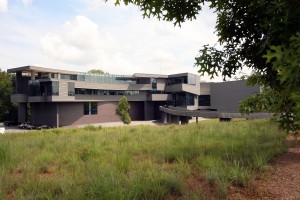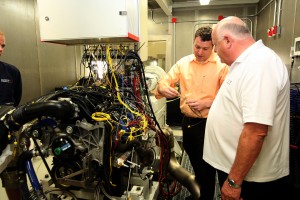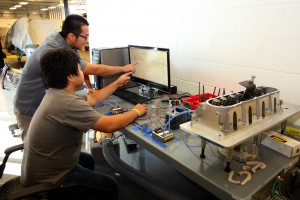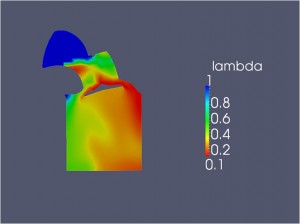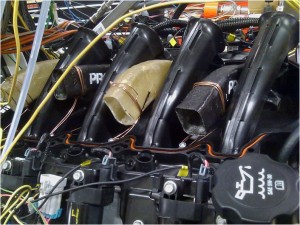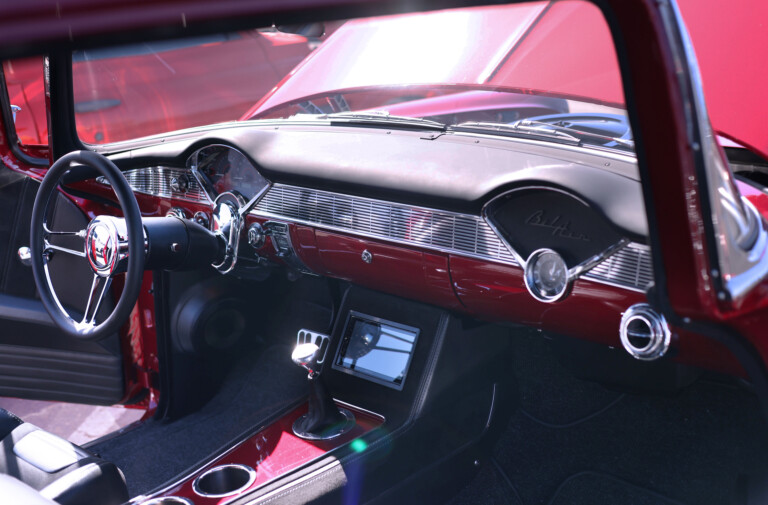Forward thinking partnership with Clemson University a sign of COMP Cams’ investment in future discoveries
At its core, CU-ICAR is a school, but it’s also much more than that.
Yes, there are classrooms, lab spaces and teachers, but when you are teaching a group of research students of this caliber, the potential is so great it is hard to call it simply a “school.”
CU-ICAR is a part of Clemson (SC) University and the letters stand for Clemson University International Center for Automotive Research. It is a graduate-level program training engineers for top-level work in the automotive industry. And the research its students and faculty are performing is quite amazing.
For example, when touring the CU-ICAR facility with Dr. Robert Prucka recently, he took us past large pieces of CNC (Computer Numerically Controlled) machining equipment. The initial thought when seeing such machinery is that they are teaching students how to program and properly use these machines, and there are many schools that do exactly that. But the purpose of the CNC machinery at CU-ICAR goes much further. Prucka says a graduate student is using the equipment as part of an advanced research program to determine more efficient ways of cutting titanium so that machinists will be able to hold their work to tighter tolerances than ever before.
And then there is the sheet metal press tucked away in a corner of one of the labs. Again, the school isn’t teaching students simply how to use the press to punch out fenders and doors. Instead, some students are using it as part of an experiment to see if electricity can be used to realign the molecules in the steel so that it holds its shape better after being pressed.
It’s like this everywhere you look.There is a scratch-built flow bench that works unlike anything else on the market, and even cars being built from scratch. Everything has a twist; a use you may not expect or a purpose beyond what the manufacturer originally intended. “Generally speaking,” Prucka deadpans, “if something is already on the market and working like it should, we have no interest in it.”
As you might expect, CU-ICAR has working relationships with many of the big auto manufacturers. One program, known as “Deep Orange,” allows select students to produce prototype cars of the future for specific manufacturers. We’ve seen the model that’s currently in development, but only after promising not to reveal anything. We can tell you it’s quite innovative and will probably make a few waves when it is revealed at this year’s SEMA Show.
But even though it has partnerships with the OEMs, Prucka says one of the school’s most valuable relationships is with the COMP Performance Group. “We’ve communicated with nearly a thousand companies in one form or another,” he says, “but they didn’t see the possibilities like COMP did. COMP Cams is one of the few companies that is forward thinking enough that they can really grasp what we can offer as a research facility. What they’ve been able to offer us has been invaluable, and hopefully, down the line we can be valuable to them too.”
One program COMP takes part in is a class where students work on engine simulations. COMP’s FAST fuel injection group provides several of its high-performance LSX composite intake manifolds that the school and students can modify. The modular nature of the FAST LSX intake makes it easy to modify for big performance gains in race engines, but that also makes it a great teaching tool. CU-ICAR students are tasked with using the simulation software to design intake ports that will create maximum power at a specific RPM range. (For a challenge, it’s normally well above or below the engine’s natural RPM range.) After working through many models, the students put their simulations to the test by actually modifying the FAST manifolds, installing them on an engine and running the engines on a dynamometer.
The quality of the engine simulations being developed at CU-ICAR goes way beyond a virtual flow bench. Prucka says it’s actually called “Unsteady 3D CFD.” CFD stands for “computational fluid dynamics” and it is a fancy way of saying that the software considers many more variables than a typical simulation. An engine is an intricate piece of machinery, and the CU-ICAR simulations take an incredible amount of that complexity into account. Everything from the movement of the pistons, to valve bounce, to how much air is displaced by the angle and size of the fuel injectors is considered in terms of how it can affect the rate of airflow moving through the intake runners.
The simulations are not only about intake runners though. Prucka showed us a working model testing an injector location that looked promising. The setup looks good at first because it is very effective at packing fuel into the combustion chamber, but the simulation also picked up a problem. At specific valve lifts the fuel from the injector missed the back of the valve, and the simulation showed how the fuel blowing directly into the chamber will wash the oil off the back of the cylinder wall–creating an engine that may make more power at the cost of a very short lifespan.
“The new knowledge is understanding how these tools can help us make better engines,” Prucka says. “More power, greater fuel economy, better efficiency. By improving the capabilities of the simulations our students can test hundreds of different intake manifold runners in an hour or thousands in an afternoon. The same thing goes for other engine components. Where before engine builders and component manufacturers had to create new parts and try them out, now we can help them take a lot of the guesswork out of it and help them get closer on the first shot.”
Besides the intakes–which CU-ICAR could simply purchase if it wanted to anyway–Prucka says COMP has provided something much more valuable: expertise. “The knowledge they have on how performance engines work is just incredible,” Prucka adds. “Being able to call somebody like (COMP Engineer) Billy Godbold and ask him what he’s seen when it comes to valve timing fluctuations, or whatever, has just been invaluable. They really know what they are doing and it has helped us with our simulations.”
So the obvious question becomes, “What does COMP get out of the relationship?”
And that’s the most interesting part. Nobody knows.
At least not yet. None other than Scooter Brothers, the Chief Operating Officer of the COMP Performance Group, admits as much. “We look at our business about the same way we do racing,” he explains. “You’ve got to always keep improving.
“We know what we’re going to be doing one year from now,” he continues, “and we even have a pretty good three- to five-year plan. But there are just too many variables to be able to accurately predict what’s going to be going on five to 10 years from now. We see our relationship with CU-ICAR as a way to stay ahead of the curve for the long term.”
Brothers says that he does see serious benefits from the simulation programs that the students spend so much time working with. “It cost us 25,000 dollars and took 18 months to develop that first manifold,” he says. “If improved computer simulations can help us cut that down, it means we can get great products to our customers more quickly and save them some money. It also makes it a lot easier to do more experimentation–to try things we might not have the time or budget to work on otherwise.”
Besides the simulation software, the relationship with CU-ICAR gives the COMP Performance Group a chance to work with some of the best young mechanical minds in the world. The student body may be small—currently there only around 180 enrollees, including both masters and PHD level students–but because of the unique nature of the school, CU-ICAR draws from a worldwide pool of applicants. COMP Cams doesn’t compete with aftermarket companies for its engineers, it targets the same level of talent that companies like Ford, Mercedes and General Motors are looking to hire. Being around the school not only helps COMP find and target the best and the brightest, it also helps the students understand what the company is all about.
“Our industry (the performance aftermarket) is so entrepreneurial, people often think they have all the answers,” Brothers says. “But we have enough humility to know it’s impossible to have all the answers. In fact, sometimes we don’t even know the right questions to ask. We work hard to learn what our customers want so that we can give it to them, but what happens when your customers don’t know what’s possible?
“That’s where a relationship with a place like this (CU-ICAR) comes in,” he continues. “We know that they are doing some fantastic research here, and our goal is to be able to help them translate that research into real-world applications. We don’t have a specific timeline, and we don’t have specific goals in terms of what or how many products we need to see come from this. But what we do have is a desire to keep improving and keep moving forward. We want to blow people’s minds with what we’ve got for them. And I believe that COMP’s great relationship with CU-ICAR will help us continue to do this for many years to come.”


